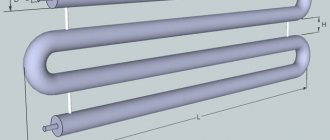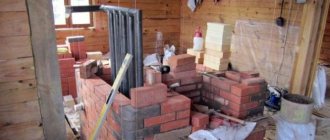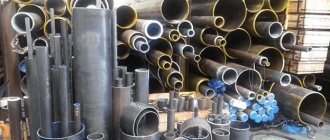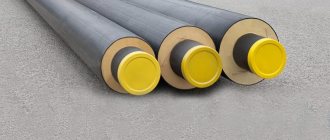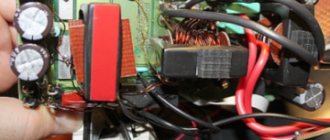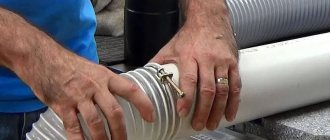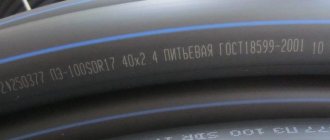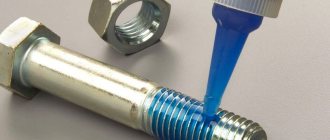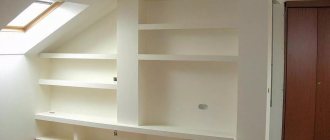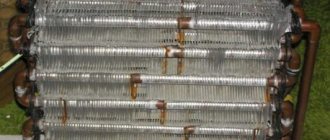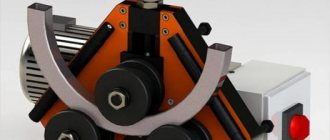Heating devices are an essential element of any water heating system. They are usually the most expensive part. A good opportunity to save money would be to use homemade radiators. They are made from smooth round steel pipes or from profile pipes. The latter option is somewhat more expensive, but allows you to reduce the depth of the device and get a more aesthetic appearance.
The use of a profile pipe for the manufacture of heating registers has a number of features. When starting to work with your own hands or deciding to buy a “homemade” product, you need to carefully weigh the pros and cons. Studying the basic rules by which heating registers are made from a profile pipe will help you avoid mistakes when working independently and will make it possible to make a competent choice of the necessary parameters.
Serpentine registers (S-shaped)
Such registers have become quite popular. The design of these devices is quite simple: there are several sections that are connected by arcs, the diameter of which is close to the sectional ones. Due to this, the hydraulic pressure inside the device is significantly reduced. As a result, the register becomes a single unit, the entire surface of which is working, which significantly increases the efficiency of such devices.
Such heating registers made of smooth pipes usually contain a large amount of carbon. In addition, registers made of other materials can be found on the market: cast iron, alloy or stainless steel.
Sectional registers made of smooth pipes
Sectional registers are in very good demand among owners of private houses. Such devices consist of pipes that are interconnected and closed with plugs. The energy carrier passes through the top pipe, enters the next one, and ultimately ends up in the discharge line. To increase heat transfer, they try to make transitions between sections as close to the edge as possible. Interpipe plugs can be elliptical or flat. The inlet pipe can be made with a flange, thread or welding. The design of sectional registers includes a threaded fitting, to which a special vent is attached to remove air from the system. Pipes for sections can have different diameters (from 25 mm to 40 cm), so choosing the appropriate option is not difficult. Transition pipes usually have a smaller diameter. In addition, one of the most important operating conditions for such installations is the pressure in the system not exceeding 1 MPa.
Location options
Heating registers, depending on placement options, can be divided into two groups: portable and stationary. Portable systems are quite mobile, and they can be moved absolutely freely - if only there was power. And such systems are usually powered by electricity. Inside portable registers there are usually heating elements of different power, which provide heating of the energy carrier. Such units can be used both in the house and in the garage, at the dacha, at a construction site, etc. Stationary registers are demanding in terms of their location. Firstly, they require permanent mounting, and secondly, they need to be connected to a boiler, which will ensure heating of the coolant and its circulation through the system.
Which metal is better
To begin with, we note that structures of this kind can be intended both for heat transfer, performing the function of radiators, and for heat intake, when a tubular register is mounted directly in the combustion chamber of a boiler or furnace.
Plus, in some models, instead of a coolant liquid, heated gas is used, for example, a radiator chimney pipe.
- Steel pipes for heating radiators are deservedly considered leaders in this market sector. Of course, the heat transfer of steel is not as high as that of aluminum or copper; it is susceptible to corrosion and requires regular maintenance. But these shortcomings are more than compensated for by the affordable price, as well as a wide range of types and sizes. In addition, it is much easier to weld ordinary ferrous metal than non-ferrous metal.
- Stainless steel is used extremely rarely for such structures. Apart from the fact that its cost, to put it mildly, is far from budget, argon welding is used for soldering stainless steel, and not every professional welder can work with it.
Important: in this case there is simply no point in using galvanized iron. Thin zinc coating simply burns out during the welding process.
As a result, the already weak weld is further affected by corrosion.
The use of copper tubular registers is justified only in the case of copper wiring throughout the house. The heat transfer of copper is four times higher than that of ferrous metals, so here we can talk about heating with pipes without radiators, or rather with a minimum number of radiators. But, firstly, the price of copper is incredibly high, and secondly, this metal is very demanding in terms of operating conditions.
Copper heating wiring.
- Copper systems require a finely purified coolant that does not have solid abrasive inclusions.
- In such systems, fittings must be copper or compatible metals such as bronze, nickel, chrome or brass. Moreover, it is strictly forbidden to combine aluminum with copper.
- Copper pipelines necessarily require high-quality grounding, as there is a danger of electrochemical corrosion.
- Copper is a soft material, so the system needs additional protection; naturally, casings and shields also cost money.
The cast iron radiator heating pipes shown in the photo are still used in industrial buildings and technical rooms. But the weight of such a design is much higher than that of a household cast-iron battery. Considering the unesthetic appearance and rather low efficiency, they are not popular.
Tubular cast iron batteries.
Tip: cast iron tubular registers are ideally suited for installation in the combustion chamber. Optimal heat capacity, low price and unpretentiousness in terms of coolant make them leaders in this area.
Material of manufacture
If you make a selection depending on the material of manufacture, then the registers can be classified into the following categories:
- Steel;
- Aluminum;
- Cast iron.
Which heating registers are best to choose? Steel registers became the most common. Their connection to the heating system is carried out by threading or welding. Such devices have good heat transfer and reasonable cost. Aluminum registers are much lighter than steel registers. In addition, they are resistant to corrosion, are made without connecting seams and have good heat dissipation. The main disadvantage of such devices is their very high price. Read also: “What types of heating registers are there – selection, calculation, characteristics.” Registers made of cast iron are connected to the heating system using a flange connection. They are quite easy to install and inexpensive. The disadvantages of cast iron products include low inertia, which significantly reduces the heating time of the registers.
Reduced heat transfer.
In order to save energy, it becomes important to reduce the heat transfer of pipes in those sections of communications that are not used for their intended purpose, for example, when moving from one building to another or in an unheated room.
There are many options for using thermal insulation materials for this. Manufacturers offer a fairly wide range to choose from, ranging from cheap fiberglass to more expensive types of polystyrene foam. You can purchase pipes with insulating elements already built into them.
To summarize, we conclude that the use of such calculations helps to significantly save money and avoid many technical obstacles when designing water and heat supply systems.
Actually, you are a desperate person if you decide to undertake such an event. The heat transfer of a pipe, of course, can be calculated and there are a great many works on the theoretical calculation of the heat transfer of various pipes.
Let's start with the fact that if you decided to heat your house with your own hands, then you are a stubborn and purposeful person. Accordingly, a heating project has already been drawn up, pipes have been selected: either metal-plastic heating pipes or steel heating pipes. Heating radiators have also already been looked at in the store.
But, before acquiring all this, that is, at the design stage, it is necessary to make a conditional relative calculation. After all, the heat transfer of heating pipes, calculated in the project, is the key to warm winters for your family. There is no room for error here.
Methods for calculating heat transfer from heating pipes
Why is the emphasis usually placed on calculating the heat transfer of heating pipes? The fact is that for commercially manufactured heating radiators, all these calculations have been made and are given in the instructions for use of the products. Based on them, you can easily calculate the required number of radiators depending on the parameters of your home: volume, coolant temperature, etc.
Tables.
This is the quintessence of all the necessary parameters collected in one place. Today the Internet contains a great many tables and reference books for online calculations of heat transfer from pipes. In them you will learn what is the heat transfer of a steel pipe or cast iron pipe, the heat transfer of a polymer or copper pipe.
All that is needed when using these tables is to know the initial parameters of your pipe: material, wall thickness, internal diameter, etc. And, accordingly, enter into the search the query “Table of heat transfer coefficients of pipes.”
This section on determining the heat transfer of pipes also includes the use of manual reference books on heat transfer of materials. Although they are becoming more and more difficult to find, all information has migrated to the Internet.
Formulas.
The heat transfer of a steel pipe is calculated according to the formula
Qtr=1.163*Str*k*(Twater - Air)*(1-efficiency of pipe insulation), W where Str is the surface area of the pipe, and k is the heat transfer coefficient from water to air.
The heat transfer of a metal-plastic pipe is calculated using a different formula.
Where is the temperature on the inner surface of the pipeline, °C; t
c is the temperature on the outer surface of the pipeline, °C;
Q—
heat flow, W;
l
—pipe length, m;
t
—coolant temperature, °C;
t
inc—air temperature, °C;
a n is the external heat transfer coefficient, W/m 2 K; d
n - outer diameter of the pipe, mm;
l—thermal conductivity coefficient, W/m K; d
in
-
internal diameter of the pipe, mm; a int - internal heat transfer coefficient, W/m 2 K;
You understand perfectly well that calculating the thermal conductivity of heating pipes is a relative value. The formulas include the average parameters of certain indicators, which may, and do, differ from those that actually exist.
For example, as a result of the experiments, it was found that the heat transfer of a polypropylene pipe located horizontally is slightly lower than that of steel pipes of the same internal diameter, by 7-8%. It is internal, since polymer pipes have a slightly thicker wall thickness.
Many factors influence the final figures obtained in tables and formulas, which is why the footnote “approximate heat transfer” is always included. After all, the formulas do not take into account, for example, heat loss through the building envelope made of different materials. There are corresponding tables of amendments for this purpose.
However, by using one of the methods for determining the heat output of heating pipes, you will have a general idea of what kind of heating pipes and radiators you need for your home.
Good luck to you, builders of your warm present and future.
Calculation of the number of ribs
Heating registers must be calculated before purchasing them. The diameter of the pipes is very important: experts believe that pipes with a cross-sectional diameter in the range from 3 cm to 8 cm are suitable for a private house. This decision is determined by the fact that a conventional heating boiler is not capable of producing a larger amount of heat, so too large surfaces will not warm up completely . When making calculations, you need to pay attention to the length of one register rib and the heat transfer per meter of this length. For example, a meter-long pipe with a 6-centimeter cross-section can heat one square meter of area. When calculating the required number of edges, the result must be rounded up. The calculation of the number of heating registers must also take into account the characteristics of the building. For example, if a building has a large number of windows and doors, or if the walls are thin and poorly insulated, then the number of registers can be increased by 20-50%.
Welding technology
Purely technologically, the connection of steel elements is made either by electric or gas welding, where the technology is almost the same
When welding registers, please note that in coil structures the joints are vertical seams, and in sectional ones they are both vertical and horizontal. It is easier to cook the latter because they are located in the plane of the table
The following requirements apply to the technology of welding horizontal seams (section + jumper):
- Tack can be carried out at one or two points, aligning the jumper vertically. Two points are located symmetrically relative to the axis of installation of the jumper.
- A joint connected by one tack point is cooked immediately, but the process must begin on the opposite side of the tack.
- A joint connected by two tack points is welded from the first point.
- Vertical joints in registers - connection of main pipes with plugs and 90° bends. The following requirements apply to seams of this type:
- If the pipe thickness is up to 3 mm, then the joint is scalded in one pass with a 2.5 mm electrode.
- If the thickness exceeds 4 mm, then welding is carried out in two passes: with a root seam, and on top with a facing roller.
- When connecting pipes with a diameter of more than 60 mm, welding is carried out in sections along the entire perimeter of the joint.
There are general rules of welding, which indicate purely technological techniques. For example, the end of a seam must be welded to the beginning, forming a “lock”. If welding is performed in two seams, then the second is carried out in the opposite direction of the first.
There are several welding parameters that you need to pay attention to when carrying out welding work. This is the diameter of the electrode, which is selected depending on the thickness of the steel workpieces being welded, this is the current strength supplied to the electrode from the welding machine, the polarity and voltage of the welding arc
Ratio of metal thickness to electrode diameter
| Metal thickness, mm | 1—2 | 3—5 | 4—10 | 12—24 | 30—60 |
| Electrode diameter, mm | 2—3 | 3—4 | 4—5 | 5—6 | 6 or more |
The current strength is selected depending on the diameter of the selected electrode. The dependence is as follows: I=Kd, where K is the coefficient of correlation with the diameter of the electrode.
| Electrode diameter, mm | >2 | 3 | 4 | 5 | 6 |
| Coefficient - "K" | 25—30 | 30—35 | 35—40 | 40—45 | 50—60 |
Heating register installation
Installing heating registers usually does not require the help of a qualified specialist, but carrying out the operation yourself requires careful preparation. The most important thing is to ensure a reliable connection between the registers and the pipeline. The connection must be able to withstand a load of 10 MPa. When welding, it is very important to maintain good quality. For clarity, you can look at the photo, which shows a diagram of connecting heating registers.
It is best to place registers along the walls. A prerequisite for installing heating devices is maintaining a constant slope, which for registers is 0.05% of its length. In addition, registers should be installed closer to the floor surface.
The efficiency of the device will depend on a large number of factors. For example, a reduced main pipe diameter will increase resistance to the energy carrier, which will affect performance. The most commonly used systems are with the following parameters:
- pipe diameter: 25-160 mm;
- sectional adapters: from 30 mm;
- distance between main pipes: from 50 mm;
- maximum pressure: 10 MPa;
- material: steel.
Advantages of heating registers
Heating registers have a number of advantages:
- possibility of using an individual drawing;
- The coolant can be not only water, but also heated steam;
- connecting the heating register to the system is extremely simple;
- excellent for heating large buildings because they have very good heat transfer;
- They're pretty cheap.
A homemade heating register is shown in the video: Conclusion Registers have already become good competitors to conventional heating radiators. Do-it-yourself heating registers allow you to save a lot, and these designs can work even in rooms with an aggressive environment.
Design characteristics
Radiators made of smooth steel pipes are most often used. Welding of smooth pipes can be registered and serpentine. Registered ones can have 2 types of pipe connections - column and thread. Column - connecting each pipe to each other on both sides using jumpers. When connecting “thread”, the jumpers are installed alternately, first on one side, then on the other. This ensures a consistent connection, and the coolant flows around all the pipes one by one.
The heater radiator can be welded not only from round, but also from square pipes. They are not much different, but they are more difficult to work with and have higher hydraulic resistance. Although such radiators are much more compact.
In this case, the contact area of the metal with the air is much larger, which increases heat transfer. Such heating registers do not look very presentable, but they heat the room well, despite the temperature outside the window.
